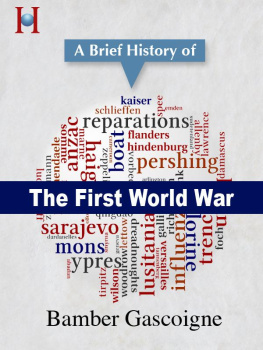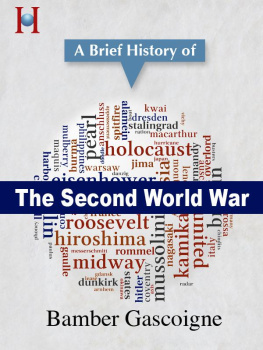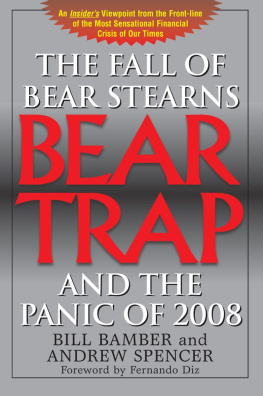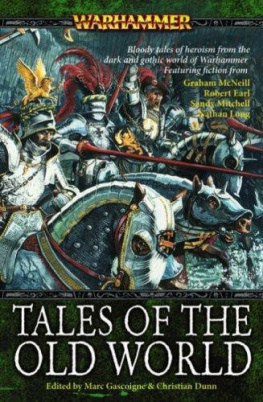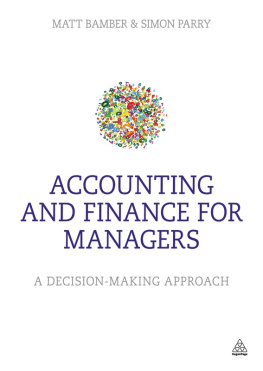Bamber Gascoigne - A Brief History of the First World War
Here you can read online Bamber Gascoigne - A Brief History of the First World War full text of the book (entire story) in english for free. Download pdf and epub, get meaning, cover and reviews about this ebook. year: 2010, publisher: HistoryWorld Ltd, genre: History. Description of the work, (preface) as well as reviews are available. Best literature library LitArk.com created for fans of good reading and offers a wide selection of genres:
Romance novel
Science fiction
Adventure
Detective
Science
History
Home and family
Prose
Art
Politics
Computer
Non-fiction
Religion
Business
Children
Humor
Choose a favorite category and find really read worthwhile books. Enjoy immersion in the world of imagination, feel the emotions of the characters or learn something new for yourself, make an fascinating discovery.
- Book:A Brief History of the First World War
- Author:
- Publisher:HistoryWorld Ltd
- Genre:
- Year:2010
- Rating:5 / 5
- Favourites:Add to favourites
- Your mark:
- 100
- 1
- 2
- 3
- 4
- 5
A Brief History of the First World War: summary, description and annotation
We offer to read an annotation, description, summary or preface (depends on what the author of the book "A Brief History of the First World War" wrote himself). If you haven't found the necessary information about the book — write in the comments, we will try to find it.
A Brief History of the First World War — read online for free the complete book (whole text) full work
Below is the text of the book, divided by pages. System saving the place of the last page read, allows you to conveniently read the book "A Brief History of the First World War" online for free, without having to search again every time where you left off. Put a bookmark, and you can go to the page where you finished reading at any time.
Font size:
Interval:
Bookmark:
HistoryWorld's Pocket History Series No. 2
A Brief History of the
First World War
Bamber Gascoigne

HISTORYWORLD
Published by HistoryWorld Ltd
1 St Helena Terrace, Richmond,
TW9 1NR, United Kingdom
www.historyworld.net
First published 2010
Copyright Bamber Gascoigne 2010
The moral right of the author has been asserted
All rights reserved
Without limiting the rights under copyright reserved above, no part of this publication may be reproduced, stored in or introduced into a retrieval system, or transmittted, in any form or by any means (electronic, mechanical, photocopying, recording or otherwise), without the prior written permission of both the copyright owner and the above publisher of this book.
ISBN: 978-1-908143-03-7
The series
HistoryWorld's Pocket History series aims to provide short, clear narrative accounts of important themes in world history. Each book consists of the history itself followed by a detailed timeline of the subject and an index. Together they provide a quick and reliable overview of the subject for anyone, from student of any age to pensioner, who wants to discover what happened and when and why.
This account of the First World War begins with the dangerous arms race developing between Germany and Britain in the early 1900s. Europe seems poised for a war, which is ignited when the heir to the Austrian empire is assassinated in 1914. There follow the four dreadful years of trench warfare, with soldiers undergoing constant bombardment and dying in their hundreds of thousands. The final end is ominous too. While an influenza pandemic adds millions more to the global death toll, the peace negotiators in Versailles impose on Germany a harsh treaty that can be partly blamed for a second world war a mere 20 years later.
The author
Bamber Gascoigne is best known in the UK as the host for twenty-five years (1962-87) of the popular quiz game University Challenge , the British version of College Bowl in the United States. But his main activity has been bringing general history to a wide public, as the author of books and the author-presenter of television documentaries. In recent years this theme has been continued in the digital medium, first in his involvement with HistoryWorld (www.historyworld.net), a website that he founded and launched in 2001, and now through this series of e-books published by HistoryWorld..
Contents
The approach of war
1914-1915
1915-1917
1918
After the War
The approach of war
The diplomatic drift towards war: 1890-1914
In the years leading to World War I there were five major powers within Europe - Austria-Hungary, Germany, Russia, France and Britain. The cast list had remained unchanged since the early 18th century, except that Prussia was now Germany. And the players were well used to the game of diplomacy in which alliances formed for defensive purposes turned into aggressive partnerships as soon as a new war developed (a circumstance considered almost inevitable sooner or later in the atmosphere of national rivalry).
However the 19th century had introduced one new element in the form of very much shorter wars. If the Seven Years' War characterized the 18th century, the Seven Weeks' War in 1866 was more typical of the 19th (the Franco-Prussian War of 1870-71 was almost equally short).
The idea of rapid victory in a short war was particularly prevalent in Germany, the victor in both the Seven Weeks' War and the Franco-Prussian War. And the German nation was both more hungry for immediate success on the international stage than its rivals, and more nervous about succumbing to hostile alliances.
The reasons were numerous. Germany had recently been transformed by Bismarck from a relatively minor player to potentially the most powerful nation in continental Europe. But as a late arrival on the world stage, it had no empire to match those of Britain, France and Russia. Nor, unlike them, had it a great navy - the most tangible symbol, perhaps, of international power.
German nervousness increased during the 1890s when alliances among the European powers seemed to be slipping beyond German control. Bismarck had worked on the assumption of hostility from France (eager to avenge the loss of Alsace and Lorraine, ceded in the treaty of Frankfurt after the Franco-Prussian War) and of a neutral stance from Britain (historically the great rival of France).
He therefore concentrated his efforts on creating alliances with his eastern neighbours, Russia and Austria-Hungary. To these he added Italy, a new nation on the verge of great power status within Europe. The Triple Alliance, agreed in 1882 between Germany, Austria-Hungary and Italy, lasted until 1915.
Bismarck's chosen path was not easy, particularly since Austria-Hungary and Russia had conflicting spheres of interest in the unstable Balkans. As a result, while Austria-Hungary and Italy remained constant allies (the three nations become known from 1882 as the Central Powers of Europe), Bismarck was constantly having to patch up or renew the alliance with Russia under the pressure of international events.
The careful edifice crumbled after Bismarck's dismissal in 1890. The new Kaiser, recognizing the incompatibility of Russia and Austria-Hungary as allies of Germany, broke off the alliance with Russia. As a result Russia and France, both equally alarmed by Germany, began secret negotiations which resulted in the Franco-Russian alliance of 1894.
Then, even more surprisingly, in 1904 France and Britain agreed an unprecedented Entente Cordiale. Austria-Hungary, a declining power, and the relatively weak Italy now seemed to be Germany's only probable allies in a European conflict. And by this time many, particularly in Germany, felt that such a conflict could not be far in the future.
All the major nations had been preparing for such an eventuality, but Germany had done so in the most deliberate fashion.
The strategic drift towards war: 1890-1914
A popular buzz-word in Germany at this time was Weltpolitik ('world politics'), meaning that the nation must assert itself on the international stage in order to claim its 'place in the sun' (another current phrase). To this end much pride was placed in the plan devised by Admiral von Tirpitz to provide the nation with a High Seas Fleet to match the naval forces of Britain.
Tirpitz's demands on the German government, the Reichstag, escalated in the inexorable pattern of any arms race. In 1898 he persuaded the politicians to pass a Navy Law providing for a fleet of 16 battleships. Two years later a new Navy Law revised the figure to 38 battleships, with a completion date of 1917 for the full fleet.
This level was still below that of the British navy, but Tirpitz argued that it would provide Germany with a Risikoflotte ('risk fleet'), meaning one too dangerous for Britain to attack. Britain radically upset the calculation by introducing in 1906 a vastly more powerful class of battleship, the first of the famous 'dreadnoughts'. Germany followed suit, upgrading its production line to the new standard.
To the German argument that Britain was escalating the stakes, Winston Churchill (when first lord of the admiralty in 1912) replied that for an island nation a powerful navy was a defensive necessity, whereas to Germany it was 'more in the nature of a luxury'.
Meanwhile the German strategy for the army in the event of war was both more secret and more illicit. It was the work of Alfred von Schlieffen, chief of the general staff from 1891 to 1906. During the second half of the 1890s, when France and Russia were in alliance and it was accepted that any war must be fought on both fronts, Schlieffen devised a two-stage plan.
Next pageFont size:
Interval:
Bookmark:
Similar books «A Brief History of the First World War»
Look at similar books to A Brief History of the First World War. We have selected literature similar in name and meaning in the hope of providing readers with more options to find new, interesting, not yet read works.
Discussion, reviews of the book A Brief History of the First World War and just readers' own opinions. Leave your comments, write what you think about the work, its meaning or the main characters. Specify what exactly you liked and what you didn't like, and why you think so.

